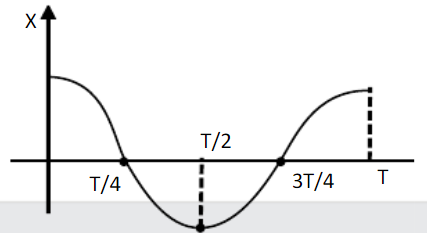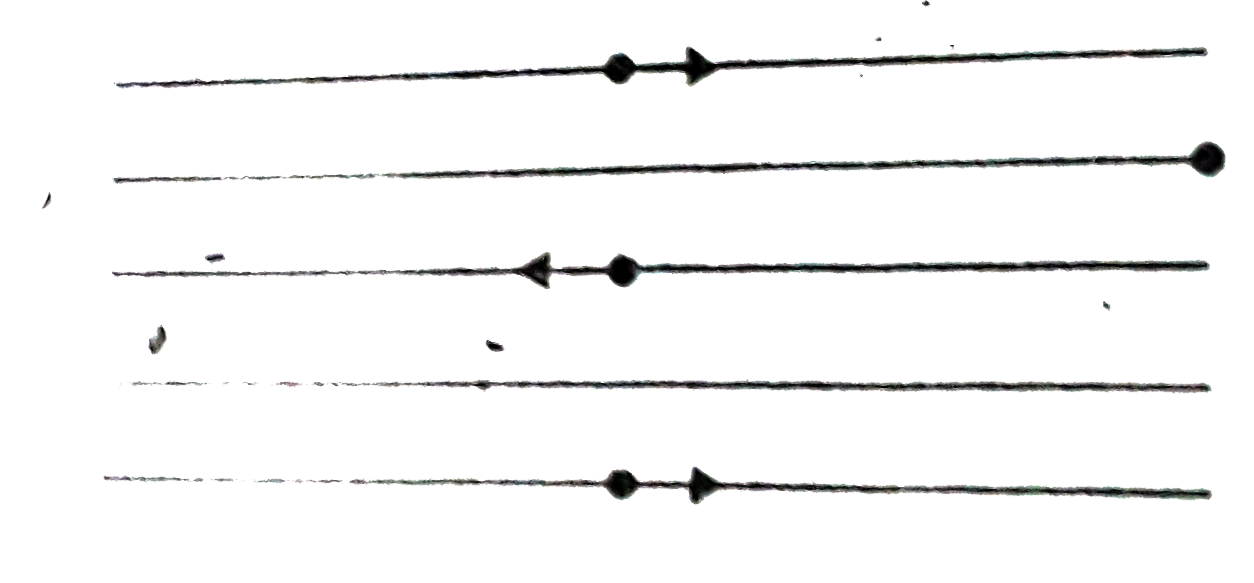At two particular closest instant of time t1 and t2 the displacements of a particle performing SHM are equal. At these instant
instantaneaous speed are equal
instantaneous acceleration are equal
phase of the motion are unequal
kinetic energies are equal
The correct Answer is:A, B, C, D
To solve the problem, we need to analyze the characteristics of a particle performing Simple Harmonic Motion (SHM) at two different instances, t1 and t2, where the displacements are equal. We will determine the instantaneous speed, instantaneous acceleration, phase of the motion, and kinetic energy at these two instances.
1. Understanding SHM Basics:
- In SHM, the displacement x of a particle from its mean position can be described by the equation:
x(t)=Asin(ωt+ϕ)
- Here, A is the amplitude, ω is the angular frequency, and ϕ is the phase constant.
2. Equal Displacements:
- Given that at two times t1 and t2, the displacements are equal, we have:
x(t1)=x(t2)
- This implies that:
Asin(ωt1+ϕ)=Asin(ωt2+ϕ)
- Since A is non-zero, we can simplify this to:
sin(ωt1+ϕ)=sin(ωt2+ϕ)
3. Finding Instantaneous Speed:
- The instantaneous speed v in SHM is given by the derivative of displacement:
v(t)=dxdt=Aωcos(ωt+ϕ)
- At t1 and t2, since the displacements are equal, we can analyze the speed:
v(t1)=Aωcos(ωt1+ϕ)
v(t2)=Aωcos(ωt2+ϕ)
- The values of cos(ωt1+ϕ) and cos(ωt2+ϕ) may not be equal, hence the instantaneous speeds may not be equal.
4. Finding Instantaneous Acceleration:
- The instantaneous acceleration a is given by:
a(t)=d2xdt2=−Aω2sin(ωt+ϕ)
- Since sin(ωt1+ϕ)=sin(ωt2+ϕ), we find that:
a(t1)=−Aω2sin(ωt1+ϕ)
a(t2)=−Aω2sin(ωt2+ϕ)
- Thus, the instantaneous accelerations are equal because they depend on the same sine value.
5. Phase of the Motion:
- The phase of the motion at t1 and t2 can be expressed as:
ϕ1=ωt1+ϕ
ϕ2=ωt2+ϕ
- Since t1 and t2 are different, ϕ1 and ϕ2 will also be different.
6. Kinetic Energy:
- The kinetic energy KE in SHM is given by:
KE=12mv2
- Since the speeds at t1 and t2 are not necessarily equal, the kinetic energies may also differ.
Summary of Results:
- Instantaneous Speed: Not equal.
- Instantaneous Acceleration: Equal.
- Phase of Motion: Not equal.
- Kinetic Energy: Not necessarily equal.
- In SHM, the displacement x of a particle from its mean position can be described by the equation:
x(t)=Asin(ωt+ϕ)
- Here, A is the amplitude, ω is the angular frequency, and ϕ is the phase constant.
- Given that at two times t1 and t2, the displacements are equal, we have:
x(t1)=x(t2)
- This implies that:
Asin(ωt1+ϕ)=Asin(ωt2+ϕ)
- Since A is non-zero, we can simplify this to:
sin(ωt1+ϕ)=sin(ωt2+ϕ)
- The instantaneous speed v in SHM is given by the derivative of displacement:
v(t)=dxdt=Aωcos(ωt+ϕ)
- At t1 and t2, since the displacements are equal, we can analyze the speed:
v(t1)=Aωcos(ωt1+ϕ)
v(t2)=Aωcos(ωt2+ϕ)
- The values of cos(ωt1+ϕ) and cos(ωt2+ϕ) may not be equal, hence the instantaneous speeds may not be equal.
- The instantaneous acceleration a is given by:
a(t)=d2xdt2=−Aω2sin(ωt+ϕ)
- Since sin(ωt1+ϕ)=sin(ωt2+ϕ), we find that:
a(t1)=−Aω2sin(ωt1+ϕ)
a(t2)=−Aω2sin(ωt2+ϕ)
- Thus, the instantaneous accelerations are equal because they depend on the same sine value.
- The phase of the motion at t1 and t2 can be expressed as:
ϕ1=ωt1+ϕ
ϕ2=ωt2+ϕ
- Since t1 and t2 are different, ϕ1 and ϕ2 will also be different.
- The kinetic energy KE in SHM is given by:
KE=12mv2
- Since the speeds at t1 and t2 are not necessarily equal, the kinetic energies may also differ.
- Instantaneous Speed: Not equal.
- Instantaneous Acceleration: Equal.
- Phase of Motion: Not equal.
- Kinetic Energy: Not necessarily equal.
Topper's Solved these Questions
- LINEAR AND ANGULAR SIMPLE HARMONIC MOTIONBOOK - CENGAGE PHYSICS ENGLISHCHAPTER - LINEAR AND ANGULAR SIMPLE HARMONIC MOTIONEXERCISE - Assertion Reasoning
6 Videos
- LINEAR AND ANGULAR SIMPLE HARMONIC MOTIONBOOK - CENGAGE PHYSICS ENGLISHCHAPTER - LINEAR AND ANGULAR SIMPLE HARMONIC MOTIONEXERCISE - Comprehension
33 Videos
- LINEAR AND ANGULAR SIMPLE HARMONIC MOTIONBOOK - CENGAGE PHYSICS ENGLISHCHAPTER - LINEAR AND ANGULAR SIMPLE HARMONIC MOTIONEXERCISE - Single Correct
107 Videos
- KINETIC THEORY OF GASES AND FIRST LAW OF THERMODYNAMICSBOOK - CENGAGE PHYSICS ENGLISHCHAPTER - KINETIC THEORY OF GASES AND FIRST LAW OF THERMODYNAMICSEXERCISE - Interger
11 Videos
- MISCELLANEOUS KINEMATICSBOOK - CENGAGE PHYSICS ENGLISHCHAPTER - MISCELLANEOUS KINEMATICSEXERCISE - Interger type
3 Videos
Similar Questions
Two particles are performing SHM in same phase. It means that
View SolutionA wave travelling on a string at a speed of 10ms−1 causes each particle of the string to oscillate with a time period of 20 ms. (a) What is the wavelength of the wave ? (b) If the displacement of a particle is 1.5 mm at a certain instant, what will be the displacement of a particle 10 cm away from it at the same instant ?
View SolutionDisplacement time graph of particle performing SHM is as shown in figure. Assume that mean position is at x=0

View SolutionVelocity of a particle varies with time as v=4t. Calculate the displacement of particle between t=2 to t=4 sec.
View SolutionA particle simple harmonic motion completes 1200 oscillations per minute and passes through the mean position with a velocity 3.14ms−1. Determine displacement of the particle from its mean position. Also obtain the displacement equation of the particle if its displacement be zero at the instant t=0.
View SolutionThe coordinates of a particle moving in XY-plane at any instant of time t are x=4t2,y=3t2. The speed of the particle at that instant is
View SolutionA simple harmonic progressive wave in a gas has a particle displacement of y=a at time t=T/4 at the orgin of the wave and a particle velocity of y =v at the same instant but at a distance x=λ/4 from the orgin where T and λ are the periodic time and wavelength of the wave respectively. then for this wave.
View SolutionIn the figure, dots and arrows show the position and the velocity of a paritcle executing SHM. What are the phases at the five indicated instants when the position at time t is given by
x=Asin(ωt+ϕ)

View SolutionTwo particles are executing SHM in a straight line. Amplitude A and the time period T of both the particles are equal. At time t=0, one particle is at displacement x1=+A and the other x2=(−A2) and they are approaching towards each other. After what time they across each other? T4
View SolutionTwo particles A to B perform SHM along the same stright line with the same amplitude 'a' same frequency 'f' and same equilbrium position 'O'. The greatest distance between them is found to be 3a/2. At some instant of time they have the same displacement from mean position. what is the displacement?
View Solution
